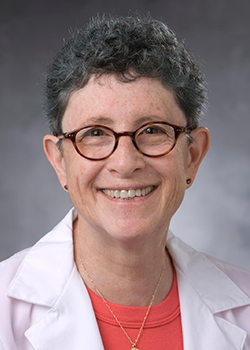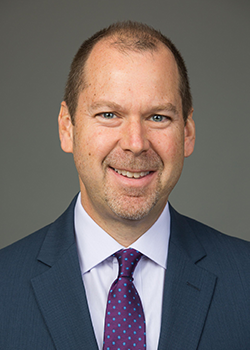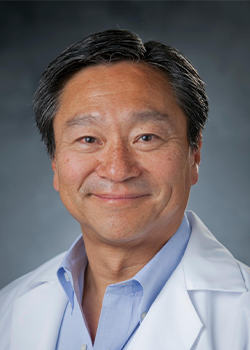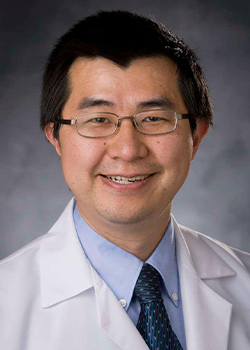
More Options For People With Blood Cancers
For decades, bone marrow transplantation has saved the lives of patients with blood cancers or other inherited or acquired bone marrow diseases. But today, it’s helping more people than ever because medical advances have made the procedure feasible for more patients.
Bone marrow is spongy tissue in our bones that houses the blood stem cells that give rise to red blood cells, platelets, and the workhorses of the immune system, white blood cells. In a bone marrow transplant, stem cells from healthy bone marrow or blood are infused into a patient to do the work of producing blood cells. Patients with certain blood cancers like lymphoma may need a transplant if the chemotherapy or radiation necessary to kill their cancer also kills their bone marrow. In other cases, the recipient’s bone marrow stem cells may be producing blood cells, but those cells aren’t up to the task of recognizing and killing cancer and need to be replaced with stem cells from a healthy donor.

The transplanted cells can come from the patient (collected ahead of time) or from a donor. In the past, patients in need of a transplant had to have a matched donor, meaning that recipient and donor had the same immunologic proteins, called HLA. Otherwise, the donor cells would launch an immune attack on the recipient’s body.
Over the last few decades, researchers have made significant progress in discovering how to perform transplants using donated cells that aren’t a perfect match. Furthermore, stem cells can now be harvested not just from bone marrow but from blood and umbilical cord.
“More patients can benefit from transplantation now because there are more donor options,” said Edwin Alyea, MD, the chief medical officer of the Duke Cancer Institute. “And we can now offer reduced intensity transplants, with lower-dose chemotherapy, to patients who were previously not eligible because of age or other medical problems.”
A Larger Pool of Donor Cells
One option for people without a match is to be transplanted with stem cells from umbilical cord blood. A patient can safely receive cord blood cells that aren’t quite a perfect match because cord blood transplants are less likely to result in the donor cells attacking the recipient’s tissues, a serious and potentially life-threatening complication called graft versus host disease (GVHD).

The world’s first cord blood transplant with an unrelated donor was performed at Duke in 1993 by Joanne Kurtzberg, MD, in a pediatric patient. Three years later, Kurtzberg, who is the Jerome S. Harris Distinguished Professor of Pediatrics, transplanted unrelated cord blood into an adult.
“For the first few years, it was only [being done] at Duke, both in adults and pediatric patients,” Kurtzberg said. “We were integrally a part of the clinical trials that ultimately spread the technology to most academic medical centers around the world.”
Today, more than 50,000 of these transplants have been performed worldwide.
Cord blood transplants are particularly valuable to Black, Asian, and Latino people because these groups are underrepresented on national donor registries. That makes it harder for them to find perfect matches, which occur more frequently within rather than between ethnic groups.
The drawback to cord blood is that there are relatively few stem cells in each unit. “We dose the stem cells on the basis of body weight,” said Mitchell Horwitz, MD, professor of medicine. “The larger you are, the less likely you are to find a cord blood unit that is big enough.”
A small dose can work, but it takes longer for the stem cells to settle in and start making blood cells, a process known as engraftment. “That takes about 15 days for an adult donor and about 24 days for cord blood,” said Horwitz. “Patients are very vulnerable during that time to infection, so even reducing that by a few days will make a difference.”

Horwitz’s research focuses on ways to expand the dose of each unit by encouraging cord blood stem cells to replicate in the lab. In the past few years, he has been conducting international clinical trials testing the effectiveness of cord blood stem cells expanded by a method developed by a company called Gamida Cell. “The phase 3 clinical trial that I led was a dramatic success,” he said. “It shortens the median time to engraftment to 12 days, which is faster than any other transplant technique available.” The product, called Omdidubicel, was approved by the Food and Drug Administration (FDA) in April 2023. Prior to the approval, Duke and a few other centers had offered it to patients outside clinical trials only under expanded "compassionate use" access. The approval means many more patients will now have access to the therapy.
A newer option for patients without a perfect match is a haplo-identical transplant, in which they receive cells from a half-matched adult donor, typically a parent, child, or sibling. Medicine given after the transplant dampens the immune response among the newly transplanted cells to discourage graft versus host disease.
Haplo-identical transplants and cord blood transplants have opened up stem cell transplants to many patients who wouldn’t have been eligible a decade or two ago. “Our preference is to find a match.” Horwitz said. “But a transplant from a mismatched family member or cord blood is now very reasonable and doesn’t compromise outcome greatly.”
More Options for Chemo
It used to be that most cancer patients undergoing bone marrow transplant first had high doses of chemotherapy to wipe out every last cancer cell. But researchers have discovered that sometimes transplanted cells can recognize and kill the cancer that eluded the patient’s immune system. Some patients, with some types of blood cancer, do well with a low dose of chemo, whose primary purpose is to suppress the patient’s immune system, so it won’t reject the donor cells.
The low-dose or reduced-intensity transplant makes stem cell transplant available to older patients and those with other medical conditions who might not be able to endure high doses of chemotherapy.
More Options for Recovery

Bone marrow transplants can be arduous. Before the transplant, patients need chemo, and afterward they frequently need platelet transfusions or other interventions while their new immune system is growing. They also need to be closely monitored for signs of infection. For these reasons, patients typically spend weeks in the hospital after the transplant, which can be emotionally challenging and carries the risk of being exposed to other people’s germs.
In 1992, Duke became the first medical center in the nation to begin an outpatient bone marrow transplant program. Even today, Duke is one of only a few medical centers to offer this option. Patients receive a transfusion, then go home or to a nearby apartment if they don’t live near Duke. They come to the outpatient clinic several times a week for supportive care. This option isn’t appropriate for all patients, but Alyea said about half of Duke’s high-dose transplants are outpatient.

Nelson Chao, MD, chief of the Division of Cell Therapy, wants to go one step further. He is working with Anthony Sung, MD, associate professor of medicine, on a clinical trial to see whether patients do better when follow-up care is provided at home.
“That is novel to Duke,” Chao said. “I don’t think anyone else is doing that in this country. I think we are going to see better outcomes.” The idea is that staying at home will help patients maintain their own unique microbiomes – the population of bacteria and other microbes on their skin and in their bodies – rather than picking up microbes from frequent visits to the clinic, and that this will result in fewer complications.
The trial was underway with teams providing in-home care when the COVID pandemic hit. The experience of those teams allowed the bone marrow transplant program to quickly pivot and provide at-home care for all transplant outpatients for the first four months of the pandemic to protect them from the new virus.
The Future of Stem Cell Transplant
In addition to saving the lives of people with blood cancer or bone marrow disease, stem cell transplants can be used with other conditions. Duke physicians are using it to successfully treat certain autoimmune diseases, such as scleroderma and multiple sclerosis. In babies and children, Duke physicians use it to treat inherited disorders related to metabolism, blood, or the immune system.
The field of stem cell transplant has also set the stage for promising new immunotherapies for cancer.
“Bone marrow transplant was the first immunotherapy,” Alyea said. “We gave cells [to the patient] with the idea that the cells would mediate an anti-disease response.” Emerging immunotherapies take that a step further by engineering cells to make them better cancer killers before transfusing them into the patient. Some are already FDA-approved and many more are in the pipeline.
Currently, these types of engineered-cell therapies are effective in about half of patients, but researchers are hard at work to change that. “The hope is that [one day] these therapies can be so specific that they can cure cancer with a single dose, and the person wouldn’t need a transplant or any other treatment,” Kurtzberg said.
Until then, Duke physicians will continue to provide patients undergoing stem cell transplants with the best experience and outcome possible. “Our program is dedicated to patient care first,” Chao said. “We are patient-centered and patient-focused.”
Mary-Russell Roberson is a freelance writer in Durham.
